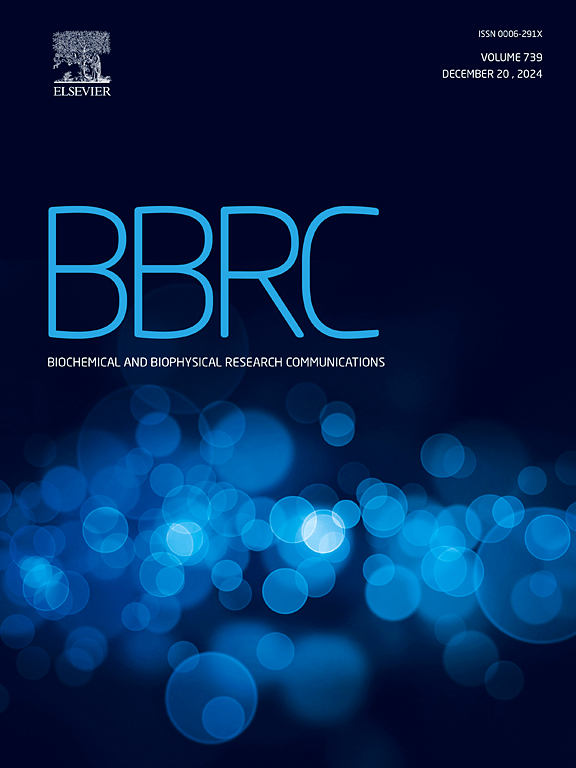夜光鱿鱼(Watasenia scintillans)的胆肠嘧啶硫转移酶
IF 2.5
3区 生物学
Q3 BIOCHEMISTRY & MOLECULAR BIOLOGY
Biochemical and biophysical research communications
Pub Date : 2025-06-18
DOI:10.1016/j.bbrc.2025.152215
引用次数: 0
摘要
鱿鱼(Watasenia scintillans)是一种发光的海洋生物,它利用coelenterazine 2,6-二硫酸盐(CTZ 2,6- so3h)作为发光底物。CTZ 2,6- so3h是coelenterazine (CTZ)的衍生物,可以在CTZ的两个酚羟基上进行硫酸酸化合成。CTZ由某些海洋浮游生物产生,并通过食物网广泛分布于海洋生物中。然而,CTZ 2,6- so3h仅在W. scintillans中被鉴定出来,目前尚不清楚鱿鱼是否从CTZ生物合成CTZ 2,6- so3h。在这项研究中,我们研究了一种磺化转移酶(SULT)的存在,该酶负责在W. scintillans中CTZ的磺化。对鱿鱼手臂光细胞的RNA-seq分析发现了一个推测的SULT基因,该基因在大肠杆菌中成功表达。超高效液相色谱-光电二极管阵列检测-质谱(UPLC-PDA-MS)分析证实,重组蛋白在3 ' -磷酸腺苷5 ' -磷酸硫酸酯(PAPS)存在下对CTZ具有磺化活性。其酸化产物不是CTZ - 2,6- so3h,而是CTZ - 2-单硫酸盐(CTZ - so3h)。这些发现表明,W. scintillans具有从CTZ合成CTZ 2,6- so3h的生物途径,可能涉及额外的SULT(s)。本文章由计算机程序翻译,如有差异,请以英文原文为准。
Coelenterazine sulfotransferase from the luminous squid Watasenia scintillans
The squid Watasenia scintillans is a luminous marine organism that utilizes coelenterazine 2,6-disulfate (CTZ 2,6-SO3H) as its luminous substrate. CTZ 2,6-SO3H, a derivative of coelenterazine (CTZ), can be chemically synthesized by sulfating CTZ at its two phenolic hydroxyl groups. CTZ is produced by certain marine plankton and is widely distributed among marine organisms through the food web. However, CTZ 2,6-SO3H has been identified only in W. scintillans, and it remains unclear whether the squid biosynthesizes CTZ 2,6-SO3H from CTZ. In this study, we investigated the presence of a sulfotransferase (SULT) responsible for the sulfation of CTZ in W. scintillans. RNA-seq analysis of the squid's arm photophore revealed a putative SULT gene, which was successfully expressed in Escherichia coli. The recombinant protein exhibited sulfation activity toward CTZ in the presence of 3′-phosphoadenosine 5′-phosphosulfate (PAPS), as confirmed by ultra-performance liquid chromatography-photodiode array detection-mass spectrometry (UPLC-PDA-MS) analysis. The sulfated product was not CTZ 2,6-SO3H but rather CTZ 2-monosulfate (CTZ 2-SO3H). These findings suggest that W. scintillans possesses a biosynthetic pathway for CTZ 2,6-SO3H from CTZ, which may involve additional SULT(s).
求助全文
通过发布文献求助,成功后即可免费获取论文全文。
去求助
来源期刊
CiteScore
6.10
自引率
0.00%
发文量
1400
审稿时长
14 days
期刊介绍:
Biochemical and Biophysical Research Communications is the premier international journal devoted to the very rapid dissemination of timely and significant experimental results in diverse fields of biological research. The development of the "Breakthroughs and Views" section brings the minireview format to the journal, and issues often contain collections of special interest manuscripts. BBRC is published weekly (52 issues/year).Research Areas now include: Biochemistry; biophysics; cell biology; developmental biology; immunology
; molecular biology; neurobiology; plant biology and proteomics

 求助内容:
求助内容: 应助结果提醒方式:
应助结果提醒方式:


